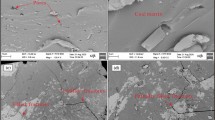Abstract
In hydraulic fracturing of producing formations in oil and gas reservoir engineering, as well as in coal gas drainage, hydraulic fractures are propped by solid particles—proppant that prevents closure of fractures under the action of compressive stresses in rocks. It is shown that alongside with lateral earth pressure, the compressive stresses in fractures are governed by additional compression generated by fracturing and by compression of rock in depression zone formed in the reservoir fluid inflow to the fracture. The compressive effect in the depression zone can be adjusted by reducing the rate of depression growth in time. This method of compression decrease in fractures is the most efficient in reservoir engineering and in shallow coal seam gas drainage. The compressive stresses in the depression zone are comparable with the lateral earth pressure, thus, the differential pressure step-up can make it possible to keep the stress–strain behavior of rock in the neighborhood of a hydraulic fracture within the limits of elastic deformation and to prevent the fracture closure with irreversible pressing-in of proppant in rock.


Similar content being viewed by others
REFERENCES
Trofimov, V.A. and Filippov, Yu.A., Influence of Stress Variation in Roof Rocks of Coal Seam on Strata Gas Conditions in Longwalling,J. Min. Sci., 2019, vol. 55, no. 5, pp. 722–732.
Serdyukov, S.V., Kurlenya, M.V., Rybalkin, L.A., and Shilova, T.V., Hydraulic Fracturing Effect on Filtration Resistance in Gas Drainage Hole Area in Coal, J. Min. Sci., 2019, vol. 55, no. 2, pp. 175–184.
Zheltov, Yu.P., Mekhanika neftegazonosnogo plasta(Mechanics of Oil-and-Gas Reservoir), Moscow: Nedra, 1975.
Barenblatt, G.I., Entov, V.M., and Ryzhik, V.M.,Dvizheniye zhidkostei i gazov v prirodnykh plastakh(The Movement of Liquids and Gases in Natural Reservoirs), Moscow: Nedra, 1984.
Svalov, A.M., Mekhanika protsessov bureniya i neftegazodobychi (Mechanics of Drilling and Oil and Gas Production), Moscow: Librokom, 2009.
Svalov, A.M., Analysis of the Patterns of Change in the Stress-Strain State of Near-Surface Rock Layers above a Developed Hydrocarbon Field, Nauch. Trudy NIPI Neftegaz GNKAR, 2019, no. 3, pp. 59–65.
Muskhelishvili, N.I., Nekotorye osnovnye zadachi matematicheskoi teorii uprugosti (Some Basic Problems of the Mathematical Theory of Elasticity), Moscow: Nauka, 1966.
Timoshenko, S.P. and Goodier J.N., Theory of Elasticity, McGraw Hill, 1970.
Rabotnov, Yu.N., Mekhanika deformiruemogo tverdogo tela (Mechanics of a Deformable Solid Body), Moscow: Nauka. 1988
Author information
Authors and Affiliations
Corresponding author
Additional information
Translated from Fiziko-Tekhnicheskie Problemy Razrabotki Poleznykh Iskopaemykh, 2020, No. 5, pp. 49–53. https://doi.org/10.15372/FTPRPI20200501.
Rights and permissions
About this article
Cite this article
Svalov, A.M. COMPRESSIVE STRESSES IN HYDRAULIC FRACTURES. J Min Sci 56, 721–725 (2020). https://doi.org/10.1134/S1062739120057044
Received:
Published:
Issue Date:
DOI: https://doi.org/10.1134/S1062739120057044




